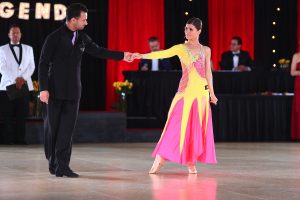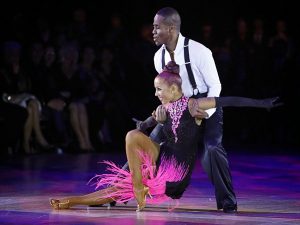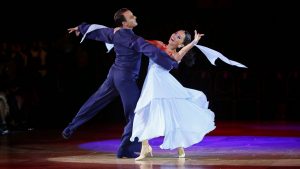
So, what is the secret? You’ve seen the videos of professional dancers flowing through step after step, so seamlessly you can’t even tell where one pattern ended and another began. But when you dance, it feels like each step clunks down about as smoothly as bricks on a wall.
The differences between what you see and what you dance yourself lie in how you direct your momentum from point A to B. When practicing the techniques below, always remember that the end goal is to dance efficiently, by conserving momentum with minimal effort. Why? Because it’s the loss of momentum that makes your dance feel so clunky.

Rolling Through the Steps
Probably the first momentum-generating technique we are taught, the goal is to simply travel in a straight line, using the following foot technique:
For Smooth/Standard: Walk normally. Notice how your heel strikes the ground first, then rolls to the front of your foot as you take your next step. Concentrate on keeping your body level by softening your knees, and push off the back foot to create your forward energy. Don’t lean forward! If it starts to feel like the concourse at an airport, you know you’re getting somewhere. Do the same thing backwards, this time by sliding the ball of the foot back, and letting it roll until the heel makes contact.
For Rhythm/Latin: Slide forward on the balls of your feet, NEVER losing contact with the floor. There’s no foot rolling action here, but there is hip-rolling action. As your weight transfers forward and your heel kisses the ground, let that forward energy settle into your hip, rolling it backwards, until it almost feels like your weight is moving towards your heel. The energy must roll forwards again, so send it into the opposite hip, stepping forward as you do, and repeat. The movement should feel like an infinity symbol rolling around in your hips, fed and maintained with your forward (or backward) momentum.
Aim for Zero
At rest, we must always return to the balls of our feet. This means we anticipate the amount of energy we need to get from point A to B, and practice until we can transfer from ball to ball without wasting energy. One way we do this, especially on the side steps, is by driving a wedge out with the inside of the free foot, then rolling to a flat on the weight transfer. Why? Because the rolling action helps to slow us down, exactly as much as our transfer to the side ‘sped us up’ so we come to rest over our foot – at zero. In smooth/standard, we use this technique for our forward and backward movements too, rolling through our foot to ensure continuous movement.
Of course, we don’t actually want to stop moving on the dance floor – we want to stay balanced and in control. Because uncontrolled momentum is lost momentum.
Blending the Movement
The above techniques are great for single-direction travel, but what about changing directions (i.e. turns)? We are already completing each weight change on the balls of our feet, which is the best place for them to pivot, if needed. Now it’s up to our body rotation (smooth/standard), or our hip rotation (rhythm/Latin) to rotate strongly enough to turn the rest of our body along a new path. This includes anything from the waltz reverse turn to a triple spin in mambo – the only change in our bodies is how strongly we rotate. Also, we must make the turn as we arrive on a new foot, or in others words, the last instant before our forward energy would stop. Wait longer, and you’ll have to ‘force’ the twist to build up momentum again. Turn too early, and you won’t be balanced on the ball, and end up falling out of the turn. Blend the energy from the previous movement into the new one, and nothing will be lost.

Juggling Energy
In ballroom dancing, your partner is just as important as you are for conserving momentum. The two of you must be constantly working in tandem or in opposition to each other, in order to keep energy juggling between you. One common way this is expressed is through a light but responsive frame, which acts as a shock absorber for any movement – it can compress and extend, but always with resistance, and like the willow branch, it immediately snaps back to place once the pressure is reduced. Often, the follower acts as a shock absorber for the leader, bending slightly to receive his momentum, which then travels into her body and moves her a split second later. A back-leading follower might think she is helping, but in reality she’s killing the momentum for both of them.
Remember that, like the fast car, there are no sudden stops or changes. Work hard to make every movement soft but irresistible, and enjoy the gloriously flowing dance that arises.
Full Credit to the Author: Ian Crewe